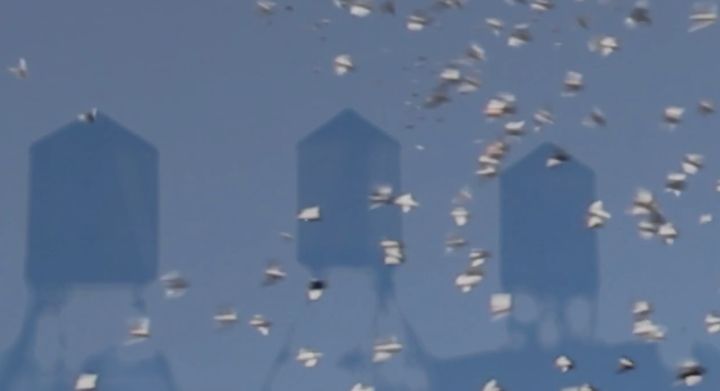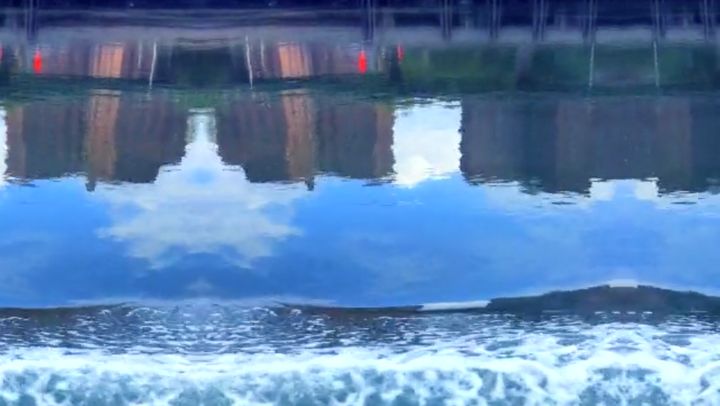For Graciela Cassel, the labyrinth that is now an integral part of her art is a metaphor for life. “There is, with the labyrinth, a way in and a way out, but you can go down so many pathways. I am enamored with labyrinths, riddles and puzzles.”
Graciela Cassel was born in Buenos Aires, Argentina, and reports having a wonderful childhood. She has a younger sister, an architect, who has remained in Argentina, unlike Graciela, who now makes New York her home. Cassel believes that her curiosity and creativity as an artist come from having a father who was a chemist who was always investigating things. “My father built a factory and all the family was involved in his investigations.”

When it was time for school, Cassel went to English and American schools, due in large part to grandparents who wanted the children to have the best education possible. Her grandparents, specifically her grandmother, Lina, emerges as a huge influence. “My grandmother was a very loving person and took care of her family. She was quite lively. My family was Jewish and Catholic and they had to leave Germany because of their religion. That was how my grandparents ended up in Argentina. But, back to my grandmother, she was a stylish and unique woman. My grandparents had art deco furniture in their house and impressionist paintings on the walls. As a child I loved looking up and around me at all the art.”

Cassel attended a small high school where she was taught Spanish in the mornings and English in the afternoons. At this small school a lot of emphasis was placed on the arts and Cassel found herself becoming more and more interested in the visual arts. However, this was at a time when there was mounting tension and violence in the Argentinian society and more than ten people could not get together. “So many relationships got destroyed during this period, because people, artists in particular, could not talk. Could not exchange ideas. This was a travesty for a society that depends on people getting together and talking and exchanging ideas, especially as artists. It was a really scary time.”
She would go on to study studio art in college in large part because she saw art as the place where people could create their own world. “I really needed that,” she told me, “I really needed to be able to create my own world. Art allowed me privacy and a chance to think. The studio for me became a freeing place.”

At 18, she had her first solo show, composed largely of the batik that she was doing at the time. Her graduation show from college would display the drawings, paintings, watercolors, nudes, and landscapes — very traditional subject matters that she would soon leave behind. After graduation from college, she began teaching arts and crafts to young children and found that she liked doing this very much. She liked the energy of children, their sensitivity and curiosity. She found children more adventurous in their artwork than adults and easier to mold. She would end up teaching for several years.
Meanwhile, she was working on her own art. As the artist explained to me, “In Argentina, there is a tradition of visiting the studios and workshops of 'master artists'. These are well known, respected artists who have been working for years. You can also take classes from some of these master artists. I was both visiting the studios of these artists and taking classes from them.”
She had also, over the years, amassed a group of friends who were writers, poets, visual artists, singers and theater people. One of her friends introduced her to a curator who came to visit her studio. After examining her work this curator told Graciela it was time for her to have a show. When she hesitated, the curator insisted that she was indeed ready for a show. Looking back, Cassel realized that it was a good thing that she did indeed listen to the curator and had the show, because it was well received and a painting of her grandmother, entitled simply but quite movingly, 'Lina', received an award.

“That show led to several others. I had a show of paintings and etchings in the Municipal Building, which, in turn, led to a curator wanting a show of only etchings. I fell and broke my wrist and started using the computer to draw for that show which was well received. Many people visited that show and it was reviewed by almost all the newspapers. In this regard I have to give special thanks to the curators in Argentina who have nurtured my work as it developed — in particular, Rosa Faccaro, Laura Feinsilber and Fermin Fevre.”
During this time too her work started changing. She was becoming increasingly interested in utopias, dystopias, alternate worlds, and worlds that did not quite exist. When asked what she was doing, she kept insisting that she “wanted to see what was invisible.” Her work moved radically away from being representational and became more and more about how to discover things. Before long, Graciela Cassel would set off on her own voyage of discovery, leaving her home of Argentina to forge another home in the United States, specifically in New York.


“After a while I felt that I wanted something different than what I had in Argentina, and New York City, with its fountain of energy was the difference that I wanted. Over the years I would travel to New York to visit museums and art shows, and feed a real hunger in me for art.” On one of her trips to New York she saw a gallery on the Upper West Side that she liked and when she got back home she sent them some material on her work and was offered a show. The show did well and that propelled her to move to New York permanently.
When asked if, twenty-two years later, New York has met all her expectations, the artist was quiet for a moment, thinking. “New York itself is a labyrinth, a puzzle,” she finally answered. “It takes some time to figure out this city. When I moved here, life was very different than what I thought it would be. It was incredibly stressful. I had no job. I was beginning life all over again.”
Plus, she had to get used to a new way of doing things in America. There was no going to visit the studios of artists as she had done in Argentina. Life in America was faster and more private. There was less leisure time. She had lost that vibrant community of artists that she had in Argentina. The truth is, life in America was then and remains to a large degree, quite lonely for the artist.

Despite the loneliness, Graciela Cassel has set about claiming the City as her own and recreating a community of artists around her. She would eventually enroll in the Master’s in Studio Art program at New York University, which is where I met her and was introduced to her video work. Upon completion of that program she went on to do an MFA in Studio Art at the School of the Visual Arts where she focused on sculpture, installation and video work. In addition, for the past few years she has also been interviewing artists on TransBorder Art, a platform presenting a dialogue among artists that is aired monthly on community public television stations in New York. One could say that Graciela Cassel has indeed made a place for herself in the New York art world and in New York.
Yet, as the artist is quick to remind me, Argentina is never that far from her. “Every time I am in Argentina I see and recognize myself there. I feel fully Argentinian. It is important for me to show my work in Argentina because Argentina is a part of me. But at times I feel so divided. I love America. I feel so free here. But Argentina is who I am. Is it possible to be a mixture of two things? Emotionally I feel as though I belong to Argentina more than to the United States. I feel so lost here in the US at times, but paradoxically, here, I feel so challenged. In Argentina, I guess I feel more comfortable. Labyrinths, rivers, moving waters, city, nature — the stuff of my most recent work — maybe it all has to do with me sorting out my perplexing relationship to America and to Argentina.”
Until next time.
